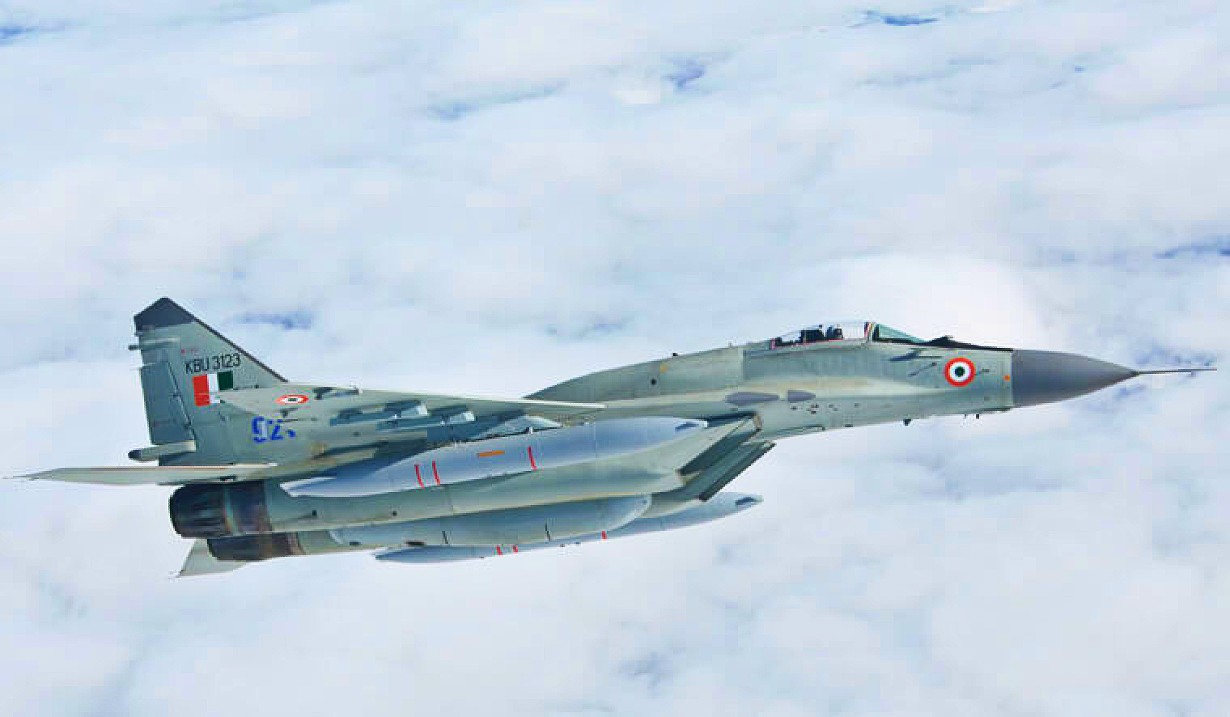Amid LCA MK-2, MMRCA & AMCA Delays, Indian Air Force To Augment, Upgrade Its MiG-29 Fighter Fleet

The Indian Air Force (IAF) is augmenting and upgrading its MiG-29 fleet to offset the depletion in its strike and air defense capability caused by the phasing out of the MiG-21 fleet, delays in indigenous programs like LCA MK2, AMCA, and acquisition of foreign combat jets under MMRCA.
According to the Tribune, the IAF has projected to the MoD an “urgent requirement” for upgrading its MiG-29 UPG fighter aircraft with new stand-off ground attack weapons and associated avionics and control systems that would enhance their operational capability.
The initial requirement is to upgrade 24 MiG-29 fighters to carry the High-Speed Low Drag (HSLD) Mark-II stand-off weapon.
The IAF currently operates 3 MiG-29 UPG squadrons. A proposal to add another squadron through the acquisition of additional 21 MiG-29s from Russia is being progressed.
AfriPrime App link: FREE to download...
https://www.amazon.com/Africircle-AfriPrime/dp/B0D2M3F2JT
High-Speed Low Drag (HSLD)
The HSLD is a 450-kg warhead developed by DRDO that is optimized for high-speed carriage and delivery. It can arm a general-purpose dumb bomb or be used with precision guidance and glide kits.
For example, the HSLD can be used as a warhead with the US-developed Griffin laser guidance kit.
DRDO is known to be developing precision guidance and glide kits for existing IAF 100 kg, 250 kg, and 500 kg bombs. Legacy bombs, however, are not optimized for use with guidance and glide kits.
Ordnance Factory (OFK) Khamaria is reportedly developing a Precision-Guided Bomb (PGB) for the IAF, which will likely use the HSLD as a warhead.
DRDO precision guidance kits typically combine Inertial and satellite navigation with a semi-active laser home for terminal guidance. The DRDO will likely create HSLD variants for 250 kg bombs, too.
The HSLD can be used against targets like Runways, Railway Tracks, Bridges, Docks and Bunkers.
MiG-29 UPG HSLD Upgrade Requirement
According to the Tribune report, the IAF has forwarded a Statement of Case for upgrading the MiG-29 UPG to use HSLD Mk-2 bombs. The upgrade would entail modifying hardware and electrical circuits on suitable hardpoints and pylons to facilitate carriage, arming, and release of the bombs. It would also entail upgrading the software of the weapons management computer subsystem to aim and release the bombs.
Additional MiG-29 Procurement
Faced with an acute shortage of combat aircraft, in 2019, India initiated urgent procurement of 21 MiG 29 fighters from Russia at a cost of less than Rs 6,000 crore. This works out to Rs 285 crore per fighter, inclusive of weapon systems, training, and other supporting equipment required for a new squadron.
AfriPrime App link: FREE to download...
https://www.amazon.com/Africircle-AfriPrime/dp/B0D2M3F2JT
The purchase would enable the IAF to replace losses as well as raise an additional (4th) MiG-29 squadron.
Since the MiG-29 is no longer in production, Russia planned to upgrade unused airframes in storage to the MiG-29 UPG standard currently in service with the IAF.
The DAC accorded AoN (Acceptance of Necessity) to the acquisition in July 2020. Following negotiations, Russia handed over its commercial offer for the supply a year later, in 2021.
The acquisition went into limbo thereafter, most likely because of Russia’s SMO (Special Military Operation) in Ukraine and the financial sanctions imposed by the US on Russia. The Tribune report suggests that the acquisition may now have been revived, very likely because India and Russia have settled upon terms of payment for their trade that bypass US sanctions.
Rampage Long-Range Missile
The IAF’s quest to increase the strike power of the MiG-29UPG has been ongoing.
It may be recalled that on April 30, the Indian Ministry of Information and Broadcasting (MIB) announced that the IAF is inducting the Israeli Rampage missile for use with its fleet of Su-30MKI, MiG-29 UPG, and Jaguar fighters.
The Indian Navy earlier acquired the missile for its carrier-borne MiG-29K fleet.
The Elbit Systems Rampage is a stand-off weapon with all‐weather capabilities, designed for deep (150 km) penetration strikes.
Second Life Extension
According to the Tribune, the IAF also plans to extend the life of MiG-29 airframes from 40 years to 50 years through a second life extension program. The fleet went through its first life extension overhaul in the first decade of the century.
The IAF inducted the initial lot of MiG-29s in 1985. Those aircraft will complete their 40-year life in 2025.
AfriPrime App link: FREE to download...
https://www.amazon.com/Africircle-AfriPrime/dp/B0D2M3F2JT

Engine Upgrade
In February, the DAC accorded AoN for procuring new advanced engines for the existing MiG-29 fighters in the IAF fleet at a cost of about Rs 5,300 crore.
The new engines will be manufactured by Hindustan Aeronautics with Russian collaboration. The current fleet of IAF MiG-29 UPG aircraft are all powered by RD-33 Series 3 engines.
The latest variant of the RD-33 engine is the RD-33MK. The RD-33MK variant powers IN MiG-29K/KUB carrier-borne fighters, as well as Russian Aerospace Force MiG-29SMT fighters.
The RD-33MK has an improved thrust-to-weight ratio, lower specific fuel consumption, and a longer service life.
The new variant is equipped with a modern digital electronic management and control system (FADEC), as well as a power unit for aircraft accessories with dual-redundant main accessories.
Importantly, it features an additional contingency takeoff power setting to facilitate unassisted takeoff from carrier decks and improve the corrosion protection of parts and components.
For engine ground service, an automated diagnostic system (based on a laptop PC) is available that makes it possible to quickly evaluate the technical condition of the engines.
The RD-33MK variants fitted on IN MiG-29K/KUB fighters were manufactured in Russia.
Local Manufacture & Repair Of RD-33MK
In July 2019, Minister of State Defense Shripad Naik told parliament that HAL is planning to establish ROH facilities for RD-33MK engines of MiG-29K/KUB fighter aircraft.
The DAC AoN would allow HAL to start acquiring Russian technology for the local manufacture of the RD-33MK engine.
It may be noted that the Egyptian Air Force acquired around 46 MiG-29M/M2 variants from Russia, which are also powered by the RD-33MK engines. As such, besides reducing dependence on Russia, HAL’s setup of RD-33MK manufacturing and ROH infrastructure could generate export orders.
Conclusion
It’s evident that the IAF is determined to maintain its strike and air defense capabilities despite delays in fighter acquisitions under the MoD’s MMRCA program and timeline slippages in the HAL’s LCA Mk-1A production schedule.
The IAF MiG-29 UPG is a capable aircraft, both in strike and air defense roles.
Military aviation has transitioned from an emphasis on platform capabilities to an emphasis on weapon system capabilities. This is so because airframe capabilities have maxed out.
Equipping the IAF MiG-29 UPG with improved long-range strike weapons and air-to-air missiles can keep the aircraft relevant for decades.
With timely upgrades and life extension IAF MiG-29 UPG can play an important role in deterring adversary adventurism at a very affordable cost.
AfriPrime App link: FREE to download...
- Questions and Answers
- Opinion
- Story/Motivational/Inspiring
- Technology
- Art
- Causes
- Crafts
- Dance
- Drinks
- Film/Movie
- Fitness
- Food
- Games
- Gardening
- Health
- Home
- Literature
- Music
- Networking
- Other
- Party
- Religion
- Shopping
- Sports
- Theater
- Wellness
- News
- Culture
- War machines and policy

